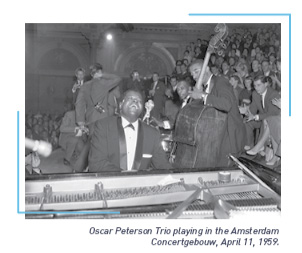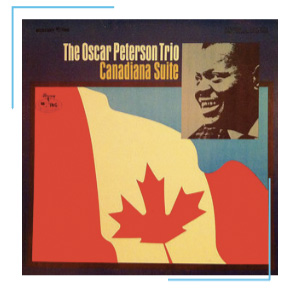 Composed 1963, arr. 2022; 35 minutes
Composed 1963, arr. 2022; 35 minutes
“The Canadiana Suite is a magnificent example of a true tone poem,” says Jens Lindemann. “It’s an eight-movement musical depiction of a virtual train ride from the East Coast to the West Coast of Canada bringing to life all of the splendor that North Americans understand inherently as we all live together on this incredible continent.” Marking the 100th anniversary of Canadian jazz legend Oscar Peterson’s birth, this chamber jazz version of the Canadiana Suite celebrates one of Peterson’s iconic works. He wrote it in 1963 as a tribute to Canada, the country Oscar Peterson was proud to call home throughout
his life.
The piece begins in the Maritimes with Ballad to the East, then moves west through the Laurentians (Laurentide Waltz), to Montreal (Place St. Henri), Toronto (Hogtown Blues), Manitoba (Wheatland), Saskatchewan (Blues of the Prairies), Calgary (March Past), and finally reaches the mist-shrouded forests of British Columbia in Land of the Misty Giants.
Peterson’s score blends blues, bebop, swing and other styles in Peterson’s arsenal, shifting in rhythm and mood with each new landscape. The result is a vivid sonic portrait of a vast and diverse country—personal, lyrical, and unmistakably Canadian. “My profession has taken me to every part of the world, none of them more beautiful than where I live,” Peterson said. “As a musician, I respond to the harmony and rhythm of life, and when I’m deeply moved it leaves something singing inside me. With a country as large and as full of contrast as Canada, I had a lot of themes to choose from when I wrote the Canadiana Suite. This is my musical portrait of the Canada I love.”
 Lindemann’s new chamber setting preserves the intimacy and spontaneity of Peterson’s original while offering fresh textures and perspectives.
Lindemann’s new chamber setting preserves the intimacy and spontaneity of Peterson’s original while offering fresh textures and perspectives.
Ballad to the East
Peterson only visited the Maritime Provinces of Nova Scotia, New Brunswick and Prince Edward Island after writing the Suite. "I saw it in my mind in terms of the color blue,” he told fellow Canadian, music writer and man-about-music Gene Lees.
Laurentides Waltz
Born and growing up in Montreal, Peterson says “I've been in the Laurentians [the mountains known in Quebec as the Laurentides] mostly in the skiing season, and it's always been a happy, swinging kind of place, with a crisp effect. This is the most seasonal section of the suite—it is supposed to be a winter scene that you're facing."
Place St. Henri
Peterson grew up in the Little Burgundy neighborhood of Montreal. Place Saint-Henri and its neighborhood lie just across Atwater Avenue.
Hogtown Blues
A formerly disparaging turn of phrase for Toronto. Peterson is with those who now consider the term stylish. “I think of Toronto lovingly. I tried to capture an impression of it by using an expansion type blues. It is fairly simply stated at the start. Using the harmonic content of the melodic line, I tried to give a feeling of the expansion this city is going through, and attempted to use the solos to typify the moods of the place at various times.”
Blues of the Prairies
“Here, too, a blues form is used,” Peterson says. "But this obviously refers to the expansiveness I saw in the prairies. The hope is to give the impression of horses and cowboys. It is set at dusk. We tried to give a rolling feeling to the music, which doesn't have the dynamic peaks in the melody that you'll find in some of the
other sections."
Wheatland
Among the more evocative writing in the Suite, Peterson vividly portrays the vast fields of wheat swaying and glittering in the breeze.
March Past
This creates a picture of the parade that precedes the Calgary Stampede. “This is a happy-time Canada feeling," he said.
Land of the Misty Giants
“Here, the feeling of the music is somewhat like that of the Eastern provinces, except that the scene as you approach is much more imposing. Yet there is an almost ethereal quality to the Rockies. That's what I tried to show, and that's the reason for the title."
— Program notes copyright © 2025 Keith Horner.
Comments welcomed: khnotes@sympatico.ca